Illumination: Projection mapping the world
by all | 20 May 2015 9:36 am
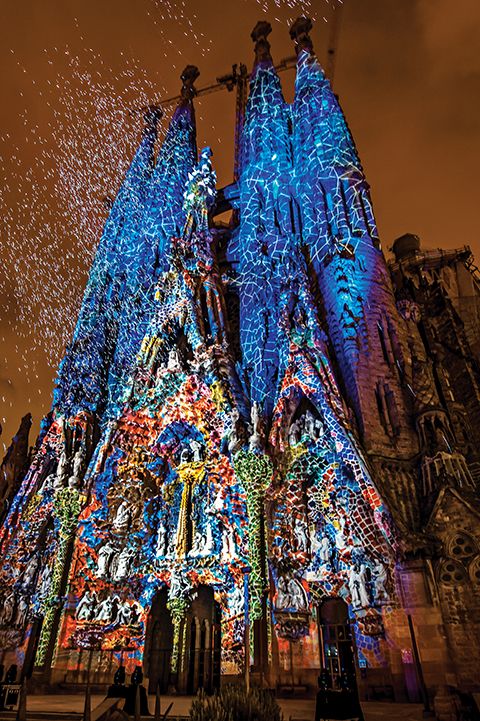 [1]
[1]Photo courtesy Christie and Moment Factory
By Mike Garrido
Thanks to advances in projection mapping technology, historic buildings, national monuments and even vaporized water have become fair game for digital artists to illuminate creatively at night, all around the world. From castles in France to mosques in Abu Dhabi, U.A.E., many grand structures have been visually transformed into a dynamic storytelling medium. Spirals on historic domes appear to spin, artifacts come to life and entire façades appear to fall and rise with the retelling of history.
Initially, however, it was the practical demands of corporate events that drove the development of projection mapping tools. Earlier artists had pushed the limits of slide projectors, but the 1990s saw the introduction of brighter, computer-driven commercial projectors, which started to appear at special events. Capable of producing between 5,000 and 10,000 lumens of light, they were key in helping video projection replace slide projection for many users.
Throughout the 1990s, corporations worked with staging and event management companies to use projectors to create oversized backdrops for presentations to investors, customers and the press. As a result, staging companies began keeping digital projectors in their rental inventory, allowing faster turnarounds for product launches and other special events. Over time, the general public began to see ambitious light shows projected onto flagship retail stores and landmarks.
As the equipment became brighter, rugged and portable, artists began looking at the shapes, contours and colours of structures, mapping them more specifically than simply using their façades as screens. With software that can warp and blend images for projection onto buildings’ irregular surfaces, the industry is now at the point where practically any light show that can be conceived can be achieved.
The following are just a few inspiring examples of illuminated display applications from around the world that have relied on projection mapping technology. All of them demonstrate the capability to communicate through a shared visual experience that could not be contained to a traditional canvas or screen. As such, they provide a snapshot of the world of projection mapping and a taste of what’s possible.
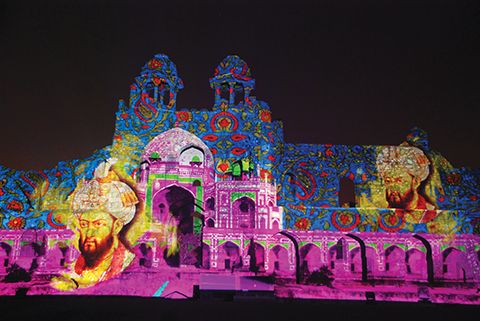 [2]
[2]In 2011, ‘The Love of Delhi’ became the first permanent projection art installation in India. Photo courtesy Christie
The Love of Delhi
The ruins of 500-year-old Purana Qila fort on a hillside in Delhi, India, have provided a canvas for a pixel-mapped light and sound show that takes visitors back almost 1,000 years. The first permanent installation of projection art anywhere in the country bathes the fort’s remaining grand ramparts, parapets, alcoves and stairs with a steady procession of visuals relating Delhi’s roots, supported by narration.
Commissioned by India Tourism Development and the country’s ministry of tourism, Ishq-e-Dilli—‘The Love of Delhi’—is a 55-minute show that depicts the national capital territory through the history of its 10 ancient cities, beginning at the 11th century with the first city of Quila Rai Pithora and ending with the present day’s modern metropolis of New Delhi and its 11 million inhabitants. The story is told through archival images, maps and three-dimensional (3-D) animation, drawing content from both historical records and literature.
The audiovisual (AV) team—including projection studio Tricolor India Schauspiel and Modern Stage Services—had to work around trees on the heritage site and address changing environmental conditions, with temperatures varying between 4 and 48 C (39 and 118 F). The multiple depths of field involved in using the fort ruins as a projection surface and making the content—guided by Two’s A Film—fit appropriately were major challenges, as was a crumbling
façade that reflected colours in different shades, which required days of calibration.
Debuting in January 2011, the show is staged twice nightly—once in Hindi and once in English.
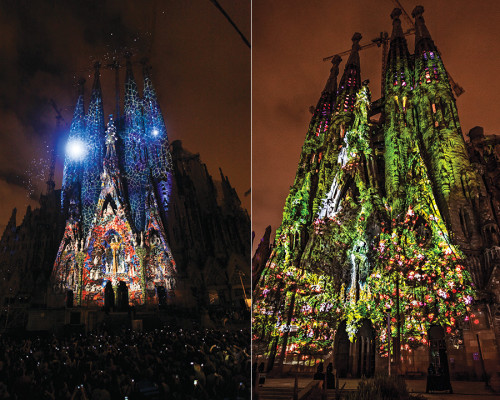 [3]
[3]Montreal-based Moment Factory projection-mapped Barcelona’s famous Sagrada Familia with a show seen by 113,000 people. Photos courtesy Christie and Moment Factory
Ode à la Vie
Montreal-based creative studio Moment Factory was commissioned by both its own hometown government and that of Barcelona, Spain, to produce a special video mapping show on a prominent façade of the latter city’s Sagrada Familia basilica, a mammoth but incomplete structure designed by the famous Catalan architect Antoni Gaudi, who died in 1926.
The basilica was illuminated for three nights as part of a special show tied to Barcelona’s La Mercè Festival in 2012. Moment Factory’s 15-minute show, titled Ode à la Vie, helped realize Gaudi’s dream of bathing the church in brilliant colours. The visuals were focused on the basilica’s intricate nativity façade, transforming its shape, morphing colours and adding whimsical flourishes.
From concept to execution, the project took four months of planning and creative development. Audiences were estimated at 113,000.
Warner Brothers International TV Gala
In 2012, projection designer Bart Kresa’s team transformed an urban streetscape on the backlot of TV and movie studio Warner Brothers in Los Angeles, Calif., into a futuristic, Japanese-style neon strip as part of a massive gala for the studio’s international TV division.
The gala attracted 1,500 people, who were treated to a rotation of performers and visual spectacles, ranging from aerialists to African dancers. Kresa’s company, BartKresa Design, had been commissioned to digitally ‘paint’ the two- and three-storey façades along the backlot’s New York Street
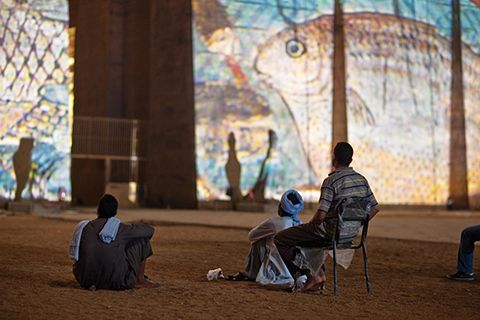 [4]
[4]A light and sound show at the Temple of Horus in Edfu, Egypt, is viewed by up to 1,000 people every night. Photo courtesy Christie and Horizon for Trading & Contracting
in vivid light, starting with neon effects reminiscent of the 1982 Ridley Scott movie Blade Runner and shifting with the evening’s events to red and then a cacophony of colourful symbols, including skulls and bones. During live performances, fire appeared to pour from the façades’ windows.
The event went on to win awards for its lighting and overall concept.
Temple of Horus
The Temple of Horus is one of the largest and best-preserved ancient structures of its kind in Egypt, dating back to 200 B.C. In 2010, the historic site in Edfu was brought back to life with a new light and sound show that uses giant columns inside the temple and the massive reliefs of the pylons at the gateway as dynamic projection surfaces.
The AV show depicts the building of the temple, presents a day in life of an ancient resident and tells the mythological story of the Egyptian gods and goddesses, Isis, Osiris, Horus and Set. The project team at Horizon for Trading & Contracting has used the lines, curves and scale of the temple for inspiration, accentuating the reliefs on its walls with light and making them appear to grow.
The 37-minute show has become a key attraction at the temple grounds, viewed by a nightly audience of up to 1,000 people equipped with multilingual headsets.
Marina Bay Sands Resort
When Singapore’s Marina Bay Sands Resort opened in 2011, it represented the world’s most expensive stand-alone casino property, costing approximately $6 billion U.S. Instead of projecting videos onto the resort’s three towers or the Skypark that tops them, however, water vapour from the bay itself serves as the focal point for a nightly public light show.
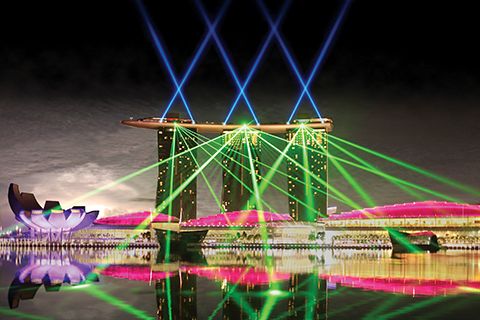 [5]
[5]Water and buildings are among the many surfaces illuminated in a 360-degree show at Singapore’s Marina Bay Sands Resort. Photos courtesy Christie
Reinforcing the resort’s position as a primary leisure destination, the multimedia show—the largest of its kind in Southeast Asia—combines water cannons, light-emitting diode (LED) illumination, fireworks, lasers and an original 13-minute symphonic score to tell the story of life and humanity. Projected video and motion graphics metaphorically trace life from childhood to old age.
“The show is designed to make us stop, take stock of our lives and appreciate the natural beauty and wonder around us,” says Michael Leven, former president and chief operating officer (COO) of Las Vegas Sands, which owns the resort (he recently became president and CEO of the Georgia Aquarium).
The production took more than three years to develop, between technology design, presentations and government approvals.
“There are challenges because this is a 360-degree show around the bay,” says Paul McCloskey, CEO and founder of Laservision Mega Media, which produced the show. “You have media in front of, behind, above, below and beside you both left and right. You are basically inside a 3-D fantasy, with the media enveloping you, so you become immersed in the experience.”
The equipment behind the show includes seven projectors that illuminate the water vapour ‘screens,’ 15 laser systems, 30 moving searchlights, 250,000 LEDs illuminating the buildings, spotlights, strobes and pyrotechnics.
The show has already been seen by millions of visitors and residents and rated one of Asia’s top new tourist attractions.
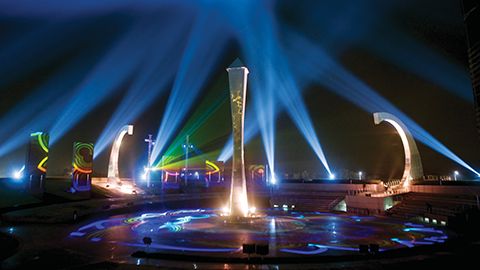 [6]
[6]The Guru Tegh Bahadur Memorial in New Delhi, India, features the region’s largest projection mapping installation, Panchtatva: The Five Elements.
Panchtatva: The Five Elements
While the aforementioned Love of Delhi was India’s first permanent projection mapping installation, it certainly isn’t the country’s only eye-catching project. New Delhi’s Guru Tegh Bahadur Memorial, built to celebrate the life and teachings of the Sikh’s ninth guru, was launched later the same year (2011) and is now the largest permanent projection mapping installation in the region.
The focal point of the memorial site is an obelisk, surrounded by semi-arches and monoliths representing disciples and gurus. At first, the site struggled to attract paying visitors, but that changed after the addition of Panchtatva, a nightly show that floods the obelisk with light and motion graphics representing the five elements of nature: air, water, fire, earth and space.
“The client wanted universal appeal to target a large diaspora of tourists,” explains Himanshu Singh Sabharwal, creative director for Tricolor India Schauspiel. “I knew we could not tell a linear story here, but I got the idea of creating a musical tribute to the five elements and the guru, which lent itself to a more fluid experience, which was perhaps the only possible option here.”
Mike Garrido is a senior product manager for Christie, which manufactures digital projectors. This article is based on the company’s publication, The Book of Transformations, which recently won the gold 2015 Digital Signage Expo (DSE) Apex Content Award in the multi-platform category. For more information, visit www.christiedigital.com[7].
- [Image]: http://www.signmedia.ca/wp-content/uploads/2015/05/OdeALaVieBarcelona6.jpg
- [Image]: http://www.signmedia.ca/wp-content/uploads/2015/05/LoveOfDelhi.jpg
- [Image]: http://www.signmedia.ca/wp-content/uploads/2015/05/edit1.jpg
- [Image]: http://www.signmedia.ca/wp-content/uploads/2015/05/EdfuTempleeHorizonforTradingandContracting.jpg
- [Image]: http://www.signmedia.ca/wp-content/uploads/2015/05/MarineBaySandsResortSingapore2.jpg
- [Image]: http://www.signmedia.ca/wp-content/uploads/2015/05/NewDelhiTheFiveElementsHorizontal.jpg
- www.christiedigital.com: http://www.christiedigital.com
Source URL: https://www.signmedia.ca/illumination-projection-mapping-the-world/